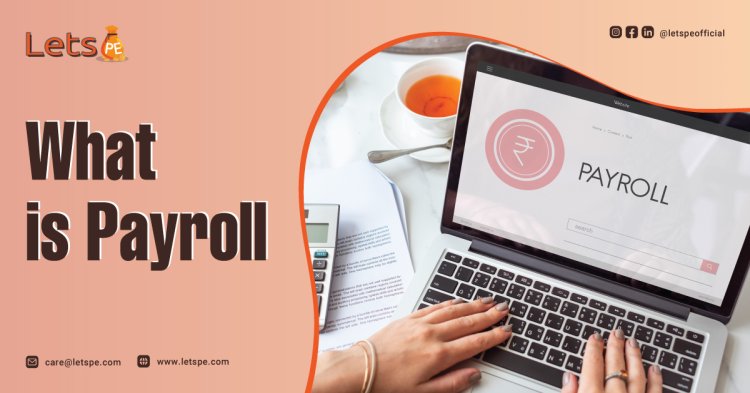"What is Payroll - Definition, processes & Services"
Payroll processing is one of the essential yet complicated business processes. The first step of payroll processing is onboarding workers and preparing the list of workers to be paid salaries.

Payroll means the company’s financial record of payments made by the employer to the workers, including salary, bonuses, salaries, hikes, etc. The company must prepare a hand's payroll for all its employees from the time they're hired till withdrawal/retirement. Processing payroll without delay in agreement with various proper respects is a significant effort of a company.
In India, payroll processing refers to the way involved in calculating the total remuneration of each hand of the company/organisation. It's an inviting process as it consists of figuring out gross payment, bonuses, net payment, daily wages, Provident Fund (PF) payment, professional duty payment, Tax Deduction at Source (TDS), allowances,etc., that are part of each workers’ monthly payment.
Payroll processing is one of the essential yet complicated business processes. Therefore, crimes might be while processing and executing hires that might hamper the workers morale and productivity. Workers calculate on the company’s process to get paid without delay, irrespective of the organisation’s size. Payroll plays an important role in a company’s Human Resource Management (HRM).
What is Payroll?
Payroll is defined as the process of paying payment to the hand of a company/organisation. It starts with preparing the list of employees to whom hires must be paid and ends with recording those expenses. The payroll process involves calculating what's due to the workers for a specific payroll cycle after confirming the needed deductions like workers’ PF deduction, TDS, etc. The payroll cycle is the gap between two payment disbursements of a hand. Generally, payroll is reused every month in India.
The payroll process requires different divisions, similar as HR, payroll and finance, to work together. Still, due to ultramodern technology, businesses can painlessly manage all the payroll processing issues.
Payroll Processing in India

The following steps are involved in the payroll processing of employees:
- Pre-Payroll Activities
The pre-payroll tasks involve the following steps:
Step 1: Onboarding employees
The first step of payroll processing is onboarding workers and preparing the list of workers to be paid salaries.
Step 2: Defining payroll policy
Organisations should define their payroll programs and get them approved by the operation for processing standard payroll execution. Every company has their own approach to hand engagement, work culture. A company needs to define the below programs for standardising payroll processing
Pay policy.
- Workers advantages policy.
- Leave and attendance policy.
- Salary components, including deductions.
- Pay schedule policy.
Step 3: Gather workers inputs
Hand inputs like bank account details, PAN, address, income tax affirmations, proof of investment,etc., are important for payroll processing. Generally, the companies collect these inputs from employees at the time of their joining/onboarding by the concerned department/squad. Each department/squad will collect and maintain hand inputs required for recycling payroll, similar as The finance department maintains information about every hand’s variable pay, perk, commission, deductions, payments, income tax declarations,etc.
The HR department maintains every hand’s information about the leave, attendance, overtime work hours, loss of pay reports, employee exit date, payment modification,etc. The admin platoon maintains information about hand- related bills, transportation bills, payment of charges,etc.
Step 4: Validate employee inputs
After the details are collected from the information handed by the workers and different brigades, the validity of their details must be checked for grace and correctness before using it for the factual payroll process. All active workers must be considered for validating data, and former workers mustn't be included in payment and observance payments. Confirmation of employees details exclude the threat of committing miscalculations in the payroll processing, and the consequences faced while changing them. Actual Payroll Conditioning The actual payroll exertion involves substantially only one step, which is as follows
Step 5: Calculation of payroll
The validated details of workers should be fed into the system maintained by the company for processing payroll to calculate every worker’s salary. This results in the net payment of each worker after confirming the necessary deductions and levies due. Net payment is generally arrived at by moderate the gross deductions from an employee's gross payment. The payroll calculations are done using spreadsheets or through payroll software.
The essential elements of payment structure for calculating the net payment include the following
- Cost to Company (CTC).
- Allowances.
- Prerequisites.
- Arrears.
- Professional tax, PF, insurance deductions.
- Leave adjustment.
- Payslip.
- Form-16.
- Reimbursements.
- Bonus, incentives, expenses and one-time payments. (if any)
- Employee financial details.
- Employee investment declarations.
- Loan repayment. (if any)
- Post-Payroll Activities
The post-payroll activities involve the following steps:
Step 6: Accounting
The salaries paid to workers must be recorded as they're the biggest charges for a company. Payroll accounts involve maintaining the company accounts with regard to workers’ hires.
Step 7: Pay employee salaries
The company must first ensure that its bank account has sufficient finances to make the payment transfers to its workers. The companies will shoot the payment bank advice statement to the concerned bank directing it to expend salaries from the payment bank account. Still, the company can automate this payment process to workers through software with an in-erected direct deposit point. The companies must also distribute payslips to each hand either collectively or through automated software.
Step 8: Compliance and reporting
During payroll processing, all legal deductions of a worker similar to TDS, PF, Employee State Insurance (ESI) and professional tax are subtracted. These payments should be made to the applicable government departments within the separate due dates. The deductions must be reported to the government departments by filing the separate forms specified by each department.
Statutory Compliances for Payroll Management
In India, companies have to follow the legal regulations in their payroll operation while provincial salaries to their workers. There are many statutory conditions that Indian companies must adhere to, and they must ensure compliance with these legal regulations. However, they will have to face heavy penalties, If companies fail to adhere to these legal regulations.

Therefore, detailed knowledge of legal nerve and compliance is needed to minimise the threat associated with the non-compliance of legal conditions. The general legal regulations that every company has to follow for their payroll operation in India are
- ESI fund and PF funds
- Professional tax
- TDS (Tax Deduction at Source)
- Gratuity
- Payroll Processing Methods
- Spreadsheets
Many companies that are at their original stage of operations make use of spreadsheet-grounded payroll operations. It's accessible to use spreadsheets because they will have only a sprinkle of workers to manage at the original stage. Spreadsheet-grounded payroll operation involves computations using standard templates that contain set fine formulas for the payment and compliance payment calculations.
Though it's cost-effective, it isn't suitable for companies when they expand and have further workers or for medium and large-sized companies. Also, the occasion cost is actually high when using a traditional system over automated styles. It's also delicate to adapt and corroborate the values to avoid any errors in this system.
Outsourcing
Payroll outsourcing means entrusting the company’s payroll prosecution to an outside or third-party agency. Many companies that don't have a devoted labour force for payroll operations conclude for outsourcing. Grounded on the company’s payroll cycle, they give the outsourced agency with payment information and other data similar to leaves, attendance, payment details,etc., of their workers every month. The outsourced agency calculates pretences and is also responsible for complying with statutory obediences.
Automation
Many payroll automation software and tools are available that carry out payroll calculations and reduce homemade sweats while adding effectiveness. Automated payroll software solves the challenges faced while using spreadsheets or outsourcing it. It eliminates the threat of fine or pastoral errors. Still, the software needs to be streamlined with the rearmost compliance laws.












